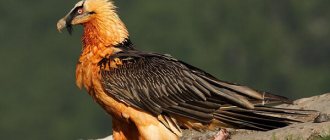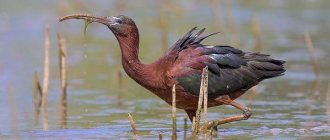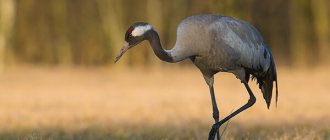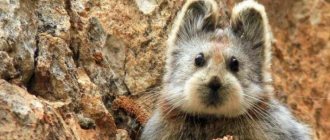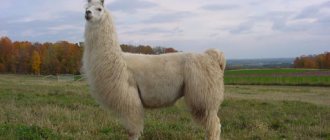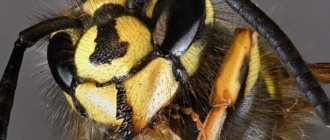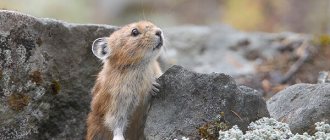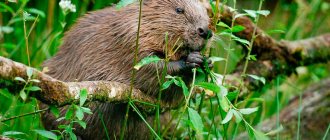The common pika is a bird from the order Passeriformes. She is the most common of her family. The bird is very hardworking and is on the move most of the day. Thanks to the coloring it is perfectly camouflaged. Constantly searches trees in search of food. And thanks to its sharp, sickle-like beak, it can check even the narrowest crack in the trunk for insects. In addition to trees, the bird, being in the city (or close to villages), looks for food in wooden houses, log houses, and in places where insects gather.
Common pika: appearance
What does a pika look like? The photo of the bird shows the fine features of the migratory songbird. The color is characteristic gray. However, it is clear from everything that even though the common pika is classified as a member of the “passerine” family, it is not a sparrow at all!
The body of an adult bird reaches a maximum of 12 centimeters in length. Weight – from 7 to 10 grams. The pika has a typical passerine build - a small head, a dense pear-shaped body, a long sharp beak and thin, tenacious legs. The pika bird has a gray mottled color. She has patterned wings and head. The abdomen is painted in a lighter tone. The bird's tail is made up of long, hard brown feathers. Using its tail, the bird deftly climbs tree trunks and moves from branch to branch. The pika's beak is dark brown above and yellow below, the iris is dark. The beak of the pika has adaptive features in the form of a pointed tip for obtaining food. The same features can indirectly include the color of the beak, merging with the color of tree trunks and branches.
Pika bird
Interesting facts about the pika
- Males of the common pika search for food at the bottom of tree trunks, and females - in their upper part.
- The American pika leads a solitary lifestyle during the non-breeding period. It unites in flocks only during the cold season.
- In the winter cold, pikas often join flocks of other birds, for example, titmice or wrens, but they do not feed together, but seek company only for greater safety.
- The pika uses its tail made of hard feathers as a support when moving through the trees in search of food, so the feathers wear off and fall out over time, and therefore they are renewed more often than once a year.
- The life expectancy of a pika is 2–3 years, but sometimes it can reach 8 years.
Where do birds of this breed live?
The habitat of pika birds is quite extensive! The bird lives in the forests of Eurasia, Scandinavia, and the Siberian taiga. Some subspecies of birds are found in northeast Korea and China. Pikas are found in the Amur River basin. One of the species of pika bird lives in Crimea, Turkey, and the vast expanses of Iran.
Depending on the region where it lives, this bird species chooses a specific biotope. But, a mandatory characteristic feature of the chosen area is the presence of shrubs and trees. It is not for nothing that the pika bird in the photo is most often captured against the background of tree bark or on a branch. Under other conditions, this small bird simply cannot survive and cannot protect itself from external threats in the form of predators and related climatic factors. And also tree trunks for the pika bird are the place where it gets food.
Pika habitat
Pikas mainly on mountain plains, since the vast majority of species prefer rocky terrain. The mountains of Central and Central Asia, the rocky expanses of China, India, and Afghanistan have become ideal territory for pika settlements.
Colonies of animals are found in the Far East and in some regions of Siberia. In Europe, pikas are extremely difficult to see, with the exception of the eastern outskirts, which are favored by only one species of rodent. Two species have found a home in North America. As can be seen from the geography of pika settlement, the animals prefer places with a cold climate.
In the photo Ili pika
Steppe pikas dig numerous holes, similar to intricate labyrinths. Such dwellings can have many entrances and reach up to ten meters in length. The burrow usually contains both pantries for storing food supplies and cozy “nests” for raising offspring.
Those species of pikas that have settled in mountainous areas feel great, making shelters in rock crevices, under stone overhangs or among the web of roots of trees and large shrubs.
In snowy areas, pikas make their home directly in the snow, masterfully digging a hole in the shape of a ball, and carefully covering their new home with dried grass and small plant roots.
Pictured is a steppe pika
Pika bird: photos and descriptions of species
Ornithologists claim that in nature there are at least 15 species of the bird in question.
Common pika
Small forest birds, as in the picture, are the common pika. This species has up to 12 subspecies. The birds are almost the same in color. But, they have a longer, curved beak than some of their relatives, and long, hard tail feathers.
Photo of a common pika
Short-legged pika
This species of bird lives not only in deciduous forests next to the common pika. The short-legged pika can also be found in gardening areas. The bird happily settles next to a person and willingly takes upon itself to fulfill its role in nature in a given habitat. External differences of this species are expressed in the white stripe above the eyes and the lighter color of the abdomen. From the name of the species it is easy to guess that the structure of the legs is also a distinctive feature.
American look
The largest representative of the pika is the American bird. The body length of this bird reaches 13 centimeters. A distinctive feature is a long, well-curved beak.
The American pika lives mainly in mixed and coniferous forests. Its northern populations are found in the corresponding part of Mexico and the southern and eastern United States.
Photo of American pika
Hodgson's pika
Ornithologists highlight another interesting species that lives in India and in the region of the western slopes of the Himalayas. This bird differs little from its relatives. However, looking at the photo of Hodgson's pika, one can note the difference in other representatives of the species. This subspecies is distinguished by its small size and thinner, curved beak.
Pika bird
Description
The male and female are colored the same. The general tone of the upperparts is brownish-brown, reddish in the area of the back and rump. Light streaks are evenly distributed over the dark background, small on the head and larger on the back. A light eyebrow is clearly visible, starting from the base of the beak and ending far behind the eye, in fact already on the neck. The bridle and eye are black; the ear coverts have a scaly pattern of light teardrop-shaped streaks. The beak is moderately long, thin, curved downwards. The mandible is dark brown, the mandible is yellowish. The wing has a complex pattern of combinations of black, tan and white. The underparts are white. The tail is wedge-shaped, reddish-brown. Juvenile birds are very similar to adults, but their coloring is generally duller. The top of the body looks scaly due to the fact that wide light fields with clear dark edges are developed in the center of the contour feathers of the top. In most of the region under consideration, it is the only species of pika.
However, in the western Caucasus, along the Black Sea coast from Gelendzhik to the border with Abkhazia, the common pika lives side by side with its twin species, the short-toed pika. You can reliably distinguish them from each other only by a set of signs, holding the birds in your hands or having high-quality photographs. The common pika has a shorter beak and longer claws (especially on the hind toe) than the short-toed pika. The light eyebrow of the common pika is white, clear and wide, the anterior edges of the eyebrows often merge above the base of the beak. The color of the belly of the common pika is white, without the reddish color on the sides.
Voice . A very important identifying feature is the voice, in particular the calls of birds of both sexes and the song performed by the male. The calls of the common pika are very monotonous, most often it is a long, thin whistle of “srrriy...” with a well-defined “vibrating” component, less often - short, abrupt cries of “sii...” or “tii...”. Often the calls form a long series. The song of the common pika is a quiet, relatively long, complex whistled phrase with a trill at the end. They sing actively at the end of winter and at the beginning of spring.
Singing abilities of pikas
Observing different species of birds, ornithologists noted that the common pika, for example, has a different voice from a garden bird. However, slight differences in the manner of singing and the sonority of voices can be found between all varieties of this bird. But, noticing them is not so easy. Long-term experience of observing several subspecies is required. But one thing can be concluded for sure: the pika bird has a unique, thin, ringing voice. Many people have known how the pika sings since childhood. These are rolling thin “tsiii - tssiiiit” that are heard from tree branches with the onset of spring and do not stop until autumn. The pika is a bird whose voice reminds us of the onset of warm, fine days. Only the nightingale can compete with this bird in its luscious singing. But, rather, these songbirds only complement each other, creating a harmonious, flooded forest choir.
Common pika
Subspecies and changing characters
The pika is a bird with geographic variability. This is manifested in body size and changes in the color of the feathers in the upper half of the body. But it can also be seasonal or individual. And this makes it much more difficult to identify geographical species. Now there are twelve of them. The differences between them are very slight, and it can be very difficult to distinguish between them.
In England and Ireland, the color of pikas is darker than those of Western Europe. In Japan - with a pronounced red tint. The singing of different subspecies also differs. Basically, their trill is loud and drawn-out, with short pauses. It was for its squeak that the bird received its name.
What birds are similar to them?
If you look at a photo of a nuthatch bird, you can find some similar features. But mainly they are visible in the structure of the bird’s body. The color of nuthatches is completely different. However, the habitat of these small birds and their feeding preferences are similar.
Sparrows are also very similar to pikas. No wonder these are representatives of the same family. But unlike pikas, sparrows are larger and are not so picky about their habitat and choice of food.
Can be compared to the pika and wagtail. This is also a very small bird with characteristic features. However, the wagtail has significantly different colors, some features of its lifestyle and choice of habitat.
Photo of nuthatch bird
Is it a migratory bird?
Pikas, which live in the south and west of their distribution range, are sedentary birds. But many northern residents go to warm southern regions for the winter. In particular, mountain pikas move down from their usual habitats during the cold season.
Where and how does it nest?
To create a nest, the female pika chooses crevice spaces between the loose bark of trees or in narrow through niches. Old abandoned birdhouses are also suitable for nesting.
The bird makes its nest in the form of a shapeless pile of thin twigs. Soft material is chosen as the base: pieces of wool, moss, bast.
Photo of pishukha
Status and protection
The steppe pika is currently one of the rarest pikas in Eurasia. The main factor that has currently led to a decline in the number of the small pika is human economic activity, primarily agriculture, accompanied by plowing of virgin steppe areas.
As a result, the typical habitats of this animal—thickets of steppe shrubs—disappear. Pikas are forced to move to biotopes that are uncharacteristic for them, where they quickly die out.
The steppe pika is listed in the IUCN Red Book , the Red Books of Russia and Kazakhstan . Status - IV category. Pikas are protected in several reserves, such as the Orenburg State Nature Reserve, the Arkaim Museum-Reserve, etc.
The following are recommended as measures to protect pikas in other territories:
- greening of steppe agriculture;
- widespread protection of remaining steppe areas;
- restoration of disturbed steppe lands;
- creation of shrub shelterbelts on overgrown fallow lands.
Video
Pika bird: description at home
This is a little freedom-loving bird. Pikas are not bred at home. But, if a bird is brought into a human home by chance, it is extremely important to provide it with proper nutrition. It is not difficult to guess what the pika eats, given the characteristics of its habitat. The basis of food for pikas are small, sedentary insects hiding in the bark of trees. These are mainly arachnid larvae, small beetles, and bark beetles. In harsh winters, birds often switch to a diet consisting of conifer seeds.
Pika bird
Peculiarities of pika nutrition
— Advertising —
The pika's main food consists of insects and other invertebrates, which this small bird deftly finds by jumping through the trees. In the crevices of the bark, the pika also looks for spiders, insect eggs, larvae and pupae. Occasionally, a bird falls to the ground in search of food.
During the cold season, pikas can also feed on plant foods, for example, seeds of coniferous trees.
Lifestyle
The common pika flies poorly and rarely. As a rule, the bird only flies from the crown of one tree to the foot of another, jumping onto the trunk of a new tree.
- 36 facts about elephants
- Rodents
- 35 facts about foxes
- Animals of Brazil
- Tarantula spider
- 34 facts about lions
In search of food, the pika moves in an upward spiral, while it rests on the tree trunk with its tail and wings. Often the bird explores the undersides of branches.
With its long, curved claws, the common pika clings very tightly to the bark of a tree. Pikas live alone, but in the fall they unite in common flocks together with birds of other species, for example, tits. It happens that sometimes in cold winters up to fifteen birds sit together and warm each other with the warmth of their bodies.
Starting in autumn, these birds travel to places where there are trees - parks, gardens and forests. However, the rest of the year the common pika vigorously defends its site and roosting site from any intruder.
These birds usually sleep in crevices under the bark, and often also live in nest boxes that have a small entrance.
Reproduction
The mating season for pikas begins in March. At this time, you can see males fighting and how they sing. Pikas begin building nests later. First, carefully select the location. Pikas prefer narrow hollows or loose bark. But the nest is always located low to the ground.
Pikas build nests from eight to twelve days. But only females prepare it for themselves; males do not care about their offspring. The bottom of the nest usually has a loose platform and consists of pieces of bark and thin branches. They rest against the walls of the hollow. It turns out that the nest does not lie in it, but is strengthened in the middle. On top, the dwelling is built from bast fibers mixed with small pieces of bark, lichen, wood and tufts of moss. The inside is lined with many small feathers mixed with wool, cobwebs, and insect cocoons.
The common pika lays five to seven eggs. Eight or nine are extremely rare. The eggs are reddish-brown, with dots and specks. There are most of them at the blunt end. Sometimes the clutch contains white eggs with barely noticeable pinkish spots.
The female incubates the clutch for 13 to 15 days. After birth, the chicks remain in the nest for the same amount of time. The female feeds them spiders and small insects. The chicks of the first clutch begin to fly in May-June. From the second - in June-July. Having grown stronger, the chicks begin to wander, but without flying far from the nest.
